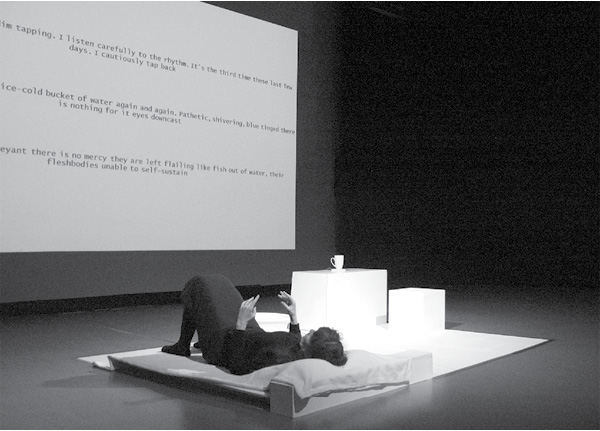
RIMA
first performed on March 20, 2015
The Lock-Up Contemporary Art Space, Newcastle, Australia
performed twice in 2015
SQUIDSILO / JULIE VULCAN, ASHLEY SCOTT
Sydney, Australia
326841553s326841553q326841553u326841553i326841553d326841553@326841553s326841553q326841553u326841553i326841553d326841553s326841553i326841553l326841553o326841553.326841553n326841553e326841553t
squidsilo.net
RIMA
SQUIDSILO / JULIE VULCAN, ASHLEY SCOTT
“RIMA” is a durational performance installation and digital media work that combines technology, creative fiction, live sound composition, and endurance performance. Conceptually we proposed to examine what the strategies for survival might look like when faced with the abject conditions of solitary confinement. Avoiding the didactic, we sought to poetically re-frame the facts behind the effects of isolation within a fictional present and a parallel sci-fi future narrative. Confined to a 2 m x 3 m white delineated space, the average size of a solitary cell, Julie’s movements ventured to illustrate the passing of time by way of examining the details and incremental shifts of the physical body in conjunction with the isolated memory via the text. Environmental sensors located within the space of the pseudo-cell captured the various actions or non-actions. These in turn triggered a relational text stream delivered to a live webpage projected on the wall. The text authored by Julie, mimicked real time thoughts, responses, and actions. Over time the accumulated text started to build into a fictional narrative somewhere between an indistinct present and a speculative parallel future.
We started thinking about this work three years ago. At that time we were drawn to the cumulative details in daily life and the relationship to associative memory. We imagined a prisoner of conscience and their relationship to their diminished world: how tiny shifts within time and space might trigger their own set of personal memory associations. During an artist residency at an old repurposed Police Lock-Up in 2013, Julie spent a day in one of the dim cells with water only and one meal. This tiny gesture, however, had a big impact. The minute glimpse into the reality of what solitary confinement actually means, alongside research and readings of personal accounts became a driving force that shaped the performance. It shifted the focus of our somewhat romantic notion of a prisoner’s diary toward a more harsh and pervasive reality. It was a turning point that influenced the creative writing which is now the fiction within the work. Forced solitary is one way of breaking the fabric of what it means to be human. In “RIMA” we attempted to look not only at the current facts but dared to dream a future world where the lessons of today could be used to envision a paradigm shift.